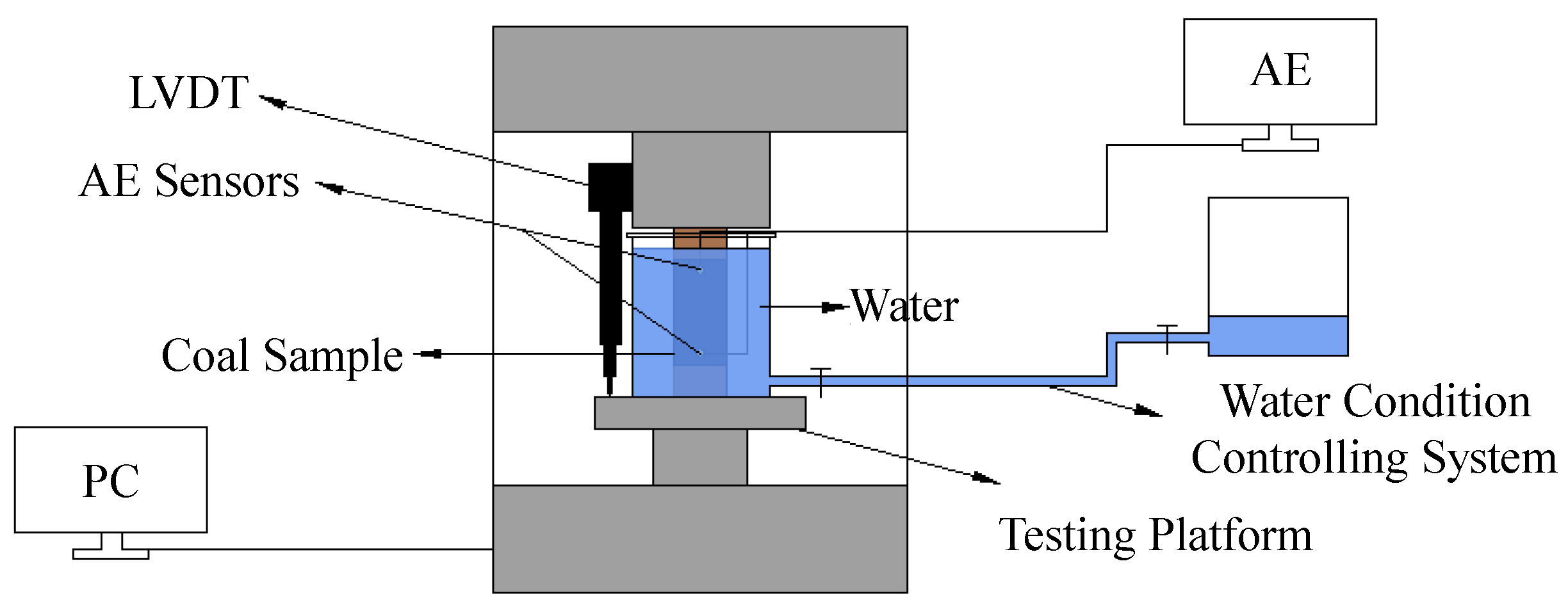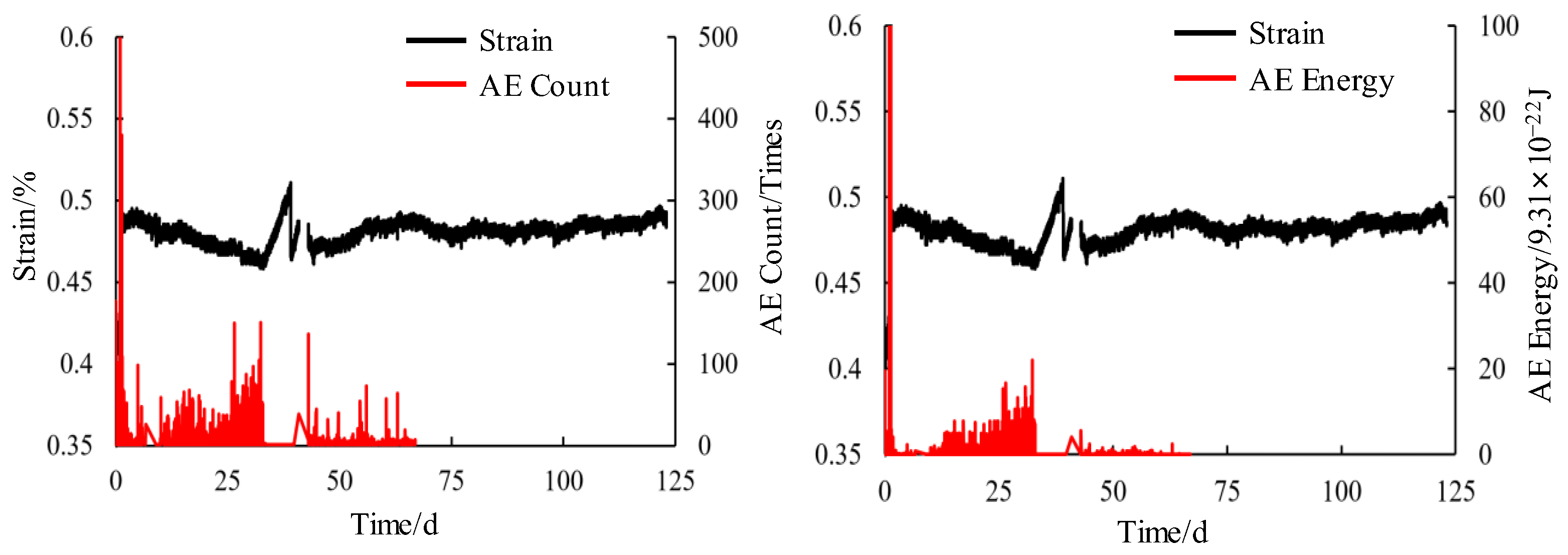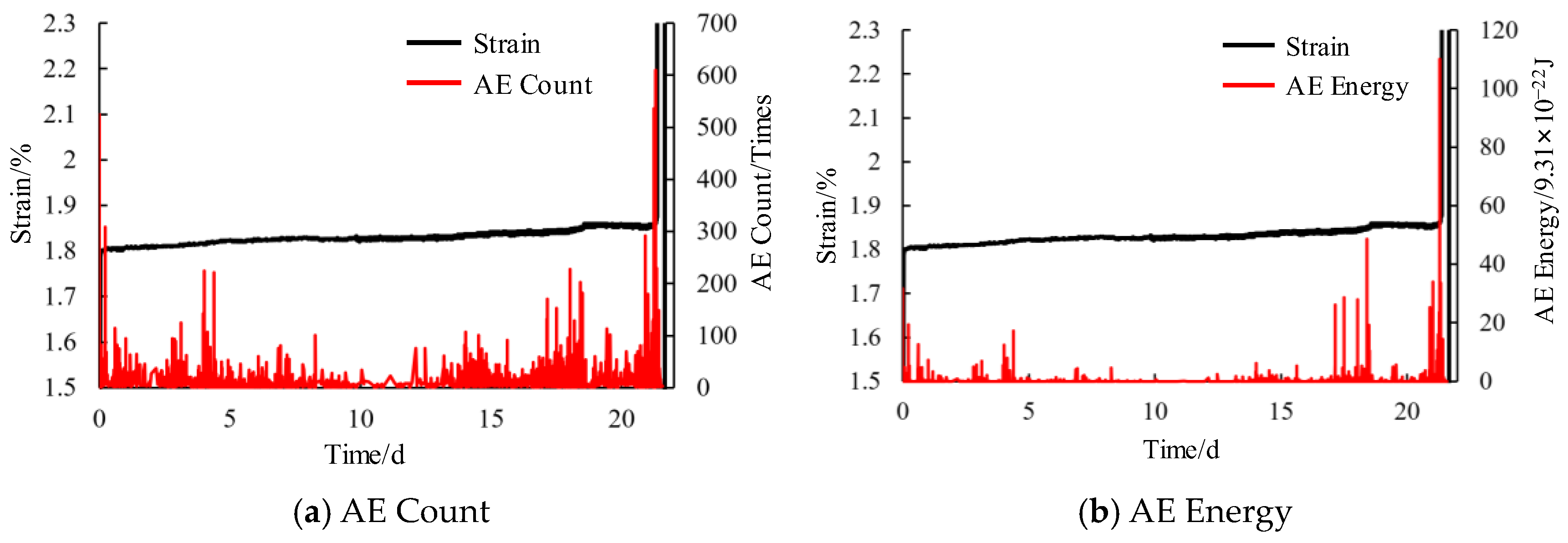Long-Term Creep Mechanical and Acoustic Emission Characteristics of Water-Immersed Coal Pillar Dam
Abstract
1. Introduction
2. Methodology
2.1. Selection of Long-Term Loading Stress
2.2. Testing Apparatus and Procedure
3. Results and Discussion
3.1. Time-Dependent Axial Strain
3.1.1. Water-Immersed Sample
3.1.2. Natural Sample
3.2. Instantaneous Loading Modulus
3.3. Acoustic Emission Characteristics
3.3.1. Water-Immersed Sample
3.3.2. Natural Sample
4. Conclusions
- (1)
- Physical–chemical water effects significantly alter early-stage deformation mechanisms. During the initial phase (0–40 days) for immersed specimens, negative creep occurred with strain rates as low as −0.00086%/d. This phenomenon correlates with non-uniform pore compaction and elastic rebound. Water infiltration promoted the continuous low-stress compaction of partially unclosed pores, triggering localized stress release and skeletal elastic recovery, thereby causing anomalous strain retraction, which is a behavior unobserved in natural condition specimens.
- (2)
- Water immersion exerts continuous deterioration effects on coal–rock throughout long-term creep. Although steady-state creep rates under both natural and saturated conditions were similar (≈3.0 × 10−6/d), instantaneous unloading tests revealed a 11.4% reduction in loading modulus for saturated specimens (2037 MPa) compared to natural samples (2300 MPa). This discrepancy stems from water molecules softening mineral particles. Concurrently, due to water filling and saturation effects, the daily AE event rate under immersion condition (127 events/day) was significantly lower than under natural conditions (500 events/day), indicating that water immersion suppresses AE generation and alters damage accumulation patterns.
- (3)
- For Daliuta CMUR, it is recommended that actual dam loads be controlled below 9 MPa to prevent accelerated creep. Although negative creep in water-saturated coal pillars temporarily mitigates deformation, continuous elastic modulus degradation necessitates higher safety redundancy in design. Microseismic monitoring should supplement real-time stability observations, and sudden energy surges or sustained event rate increases should be treated as accelerated creep precursors, which requires emergency engineering measures.
Author Contributions
Funding
Institutional Review Board Statement
Informed Consent Statement
Data Availability Statement
Conflicts of Interest
References
- Gu, D.Z.; Cao, Z.G.; Li, J.F.; Wu, B.Y.; Zhang, Y.; Jiang, B.B.; Guo, Q.; Wang, H.P.; Wu, Y.; Shi, X.M.; et al. Original experimental platform system and application of underground coal mine reservoirs. J. China Coal Soc. 2024, 49, 100–113. [Google Scholar] [CrossRef]
- Gu, D.Z. Theory framework and technological system of coal mine underground reservoir. J. China Coal Soc. 2015, 40, 239–246. [Google Scholar]
- Chen, S.S.; Huang, Q.X.; Xue, G.; Li, R.Q. Technology of underground reservoir construction and water resource utilization in Daliuta Coal Mine. Coal Sci. Technol. 2016, 44, 21–28. [Google Scholar]
- Yao, Q.L.; Tang, C.J.; Xia, Z.; Liu, X.L.; Zhu, L.; Chong, Z.H.; Hui, X.D. Mechanisms of failure in coal samples from underground water reservoir. Eng. Geol. 2020, 267, 105494. [Google Scholar] [CrossRef]
- Tang, C.J.; Yao, Q.L.; Li, Z.Y.; Zhang, Y.; Ju, M.H. Experimental study of shear failure and crack propagation in water-bearing coal samples. Energy Sci. Eng. 2019, 7, 2193–2204. [Google Scholar] [CrossRef]
- Yu, L.Q.; Yao, Q.L.; Chong, Z.H.; Li, Y.H.; Xu, Q.; Liu, Z.C. Experimental study on the moisture migration and triaxial mechanical damage mechanisms of water-bearing coal samples. Int. J. Rock Mech. Min. Sci. 2022, 160, 105263. [Google Scholar] [CrossRef]
- Wang, F.T.; Liang, N.N.; Li, G. Damage and failure evolution mechanism for coal pillar dams affected by water immersion in underground reservoirs. Geofluids 2019, 2019, 2985691. [Google Scholar] [CrossRef]
- Liu, X.S.; Song, S.L.; Wu, B.Y.; Li, X.B.; Yang, K. Study on Deformation and Fracture Evolution of Underground Reservoir Coal Pillar Dam under Different Mining Conditions. Geofluids 2022, 2022, 2186698. [Google Scholar] [CrossRef]
- Wang, W.N.; Yao, Q.L.; Xu, Q.; Chen, X.Y.; Liu, H.Y.; Li, X.H. Experimental Study on the Evolution Law of Coal Mine Underground Reservoir Water Storage Space under the Disturbance and Water—Rock Interaction Effect. Minerals 2022, 12, 1491. [Google Scholar] [CrossRef]
- Wu, Q.; Shen, J.J.; Wang, Y. Mining techniques and engineering application for “Coal-Water” dual-resources mine. J. China Coal Soc. 2017, 42, 9. [Google Scholar]
- Itô, H.; Sasajima, S. A ten year creep experiment on small rock specimens. Int. J. Rock Mech. Min. Sci. Geomech. Abstr. 1987, 24, 113–121. [Google Scholar] [CrossRef]
- Bérest, P.; Antoine Blum, P.; Pierre Charpentier, J.; Gharbi, H.; Valès, F. Very slow creep tests on rock samples. Int. J. Rock Mech. Min. Sci. 2005, 42, 569–576. [Google Scholar] [CrossRef]
- Okubo, S.; Fukui, K.; Hashiba, K. Long-term creep of water-saturated tuff under uniaxial compression. Int. J. Rock Mech. Min. Sci. 2010, 47, 839–844. [Google Scholar] [CrossRef]
- Lyu, C.; Liu, J.F.; Ren, Y.; Liang, C.; Liao, Y.L. Study on very long-term creep tests and nonlinear creep-damage constitutive model of salt rock. Int. J. Rock Mech. Min. Sci. 2021, 146, 104873. [Google Scholar] [CrossRef]
- Zhou, H.W.; Zhang, L.; Wang, X.Y.; Rong, T.L.; Wang, L.J. Effects of matrix-fracture interaction and creep deformation on permeability evolution of deep coal. Int. J. Rock Mech. Min. Sci. 2020, 127, 104236. [Google Scholar] [CrossRef]
- Zhang, L.; Zhou, H.; Wang, X.; Wang, L.; Su, T.; Wei, Q.; Deng, T. A triaxial creep model for deep coal considering temperature effect based on fractional derivative. Acta Geotech. 2022, 17, 1739–1751. [Google Scholar] [CrossRef]
- Jia, W.; Zhou, H.; Xie, S.; Wang, Y.; Hu, X.; Zhang, L. Pore-pressure and stress-coupled creep behavior in deep coal: Insights from real-time NMR analysis. Int. J. Min. Sci. Technol. 2024, 34, 77–90. [Google Scholar] [CrossRef]
- Liu, Y.; Gu, T.; Wang, Y.; Xiong, W.; Yang, X. Deformation characteristics of overlying strata in room and pillar mined-out areas under coal pillar instability. Sci. Rep. 2024, 14, 1006. [Google Scholar] [CrossRef] [PubMed]
- Zha, E.S.; Li, P.; Wu, Y.; Wu, B.Y.; Zhang, Y.; Li, Z.D.; Zhang, Z.T. Long-term monitoring and early warning of coal mine underground reservoirs—A case study in Shigetai coal mine. Sustainability 2024, 16, 10350. [Google Scholar] [CrossRef]
- Liu, X.L.; Zhang, Z.T.; Zhang, R.; Cao, Z.G.; Ren, L.; Sun, Z.W.; Zha, E.S. Energy Failure Mechanism and Bedding Effect of Soaked Coal Under Uniaxial Compression. Adv. Eng. Sci. 2025, 57, 189–200. [Google Scholar] [CrossRef]
- Cai, M.; Kaiser, P.K.; Tasaka, Y.; Maejima, T.; Morioka, H.; Minami, M. Generalized crack initiation and crack damage stress thresholds of brittle rock masses near underground excavations. Int. J. Rock Mech. Min. Sci. 2004, 41, 833–847. [Google Scholar] [CrossRef]
- Markenscoff, X. Hadamard instability analysis of “negative creep” in coupled chemo-thermo-mechanical systems. Contin. Mech. Thermodyn. 2016, 28, 351–359. [Google Scholar] [CrossRef]
- Ramesh, K.S.; Yasuda, E.; Kimura, S. Negative creep and recovery during high-temperature creep of MgO single crystals at low stresses. J. Mater. Sci. 1986, 21, 3147–3152. [Google Scholar] [CrossRef]
- Ren, D.G. Atom probe and field ion microscope investigation of the negative creep mechanism in nickel-base superalloy. J. Mater. Process. Technol. 1998, 73, 74–77. [Google Scholar] [CrossRef]
- Wang, S.H.; Lee, H.H.; Chen, C.Y.; Yang, J.R.; Kao, C.H. The variation of beta phase morphology after creep and negative creep for duplex titanium alloys. J. Mater. Sci. 2009, 44, 408–413. [Google Scholar] [CrossRef]
- Louchet, F. A model of negative creep in nickel-based superalloys. Scr. Metall. Et Mater. 1995, 33, 913–918. [Google Scholar] [CrossRef]
- Tang, H. Study on the Instantaneous and Rheological Mechanical Properties and Constitutive Model of Marble. Ph.D. Thesis, Chang’an University, Xi’an, China, 2014. [Google Scholar]
- Wang, L. Research on Time-Dependent Mechanical Behavior and Creep Model of Marble from Jinping I Underground Powerhouse. Ph.D. Thesis, Sichuan University, Chengdu, China, 2017. [Google Scholar]
- Zha, E.S.; Zhang, R.; Zhang, Z.T.; Ai, T.; Ren, L.; Zhang, Z.P.; Liu, Y.; Lou, C.D. Acoustic Emission Characteristics and Damage Evolution of Rock under Different Loading Modes. Energies 2020, 13, 3649. [Google Scholar] [CrossRef]
- Ai, T.; Wu, S.; Zhang, R.; Gao, M.; Zhou, J.; Xie, J.; Ren, L.; Zhang, Z. Changes in the structure and mechanical properties of a typical coal induced by water immersion. Int. J. Rock Mech. Min. Sci. 2021, 138, 104597. [Google Scholar] [CrossRef]
- Song, B.B.; Zhai, X.W.; Ma, T.; Wang, B.; Hao, L.; Zhou, Y.J. Effect of water immersion on pore structure of bituminous coal with different metamorphic degrees. Energy 2023, 274, 127449. [Google Scholar] [CrossRef]
- Zhang, Y.B.; Qi, X.Y.; Zou, J.G.; Rao, Y.X.; Chen, L.Z.; Zhang, L.J.; Ji, Y.C.; Liang, Z.Q. Effects of water immersion on the pore structure and thermodynamic properties of coal gangue. Fuel 2023, 346, 128273. [Google Scholar] [CrossRef]
- Liu, W.J.; Yang, K.; Zhang, S.; Zhang, Z.N.; Xu, R.J. Energy evolution and water immersion-induced weakening in sandstone roof of coal mines. Int. J. Coal Sci. Technol. 2022, 9, 53. [Google Scholar] [CrossRef]
- Li, T.; Chen, G.B.; Qin, Z.C.; Li, Q.H. Analysis the Characteristic of Energy and Damage of Coal-Rock Composite Structure Under Cycle Loading. Geotech. Geol. Eng. 2022, 40, 765–783. [Google Scholar] [CrossRef]
- Yang, H.Q.; Liu, W.Z. Microscopic Damage Mechanism of Coal Sample Under Uniaxial Compression Test Under Different Creep Pre-damage. Geotech. Geol. Eng. 2020, 38, 1675–1687. [Google Scholar] [CrossRef]
- Yang, H.C.; Li, P.; Su, S.R.; Chen, J.X. Microscopic deformation mechanism and characteristics of carbonaceous slate during the creep process. Geomech. Geophys. Geo-Energy Geo-Resour. 2024, 10, 112. [Google Scholar] [CrossRef]
- Yang, J.T.; Song, Y.Q.; Ma, H.F.; Yang, J.K.; Shao, Z.X.; Bao, W. A creep constitutive model of salt rock considering hardening and damage effects. Rock Soil Mech. 2023, 44, 2953–2966. [Google Scholar] [CrossRef]
- Zhang, C.; Cao, P.; Wang, Y.; Ning, G. Creep characteristics of plagioclase hornblende rock under natural and water-saturated conditions in deep underground. J. Cent. South Univ. Sci. Technol. 2013, 44, 1587–1595. [Google Scholar]
- Zha, E.S.; Zhang, Z.T.; Zhang, R.; Wu, S.Y.; Li, C.B.; Ren, L.; Gao, M.Z.; Zhou, J.F. Long-term mechanical and acoustic emission characteristics of creep in deeply buried jinping marble considering excavation disturbance. Int. J. Rock Mech. Min. Sci. 2021, 139, 104603. [Google Scholar] [CrossRef]
- Zhai, X.W.; Song, B.B.; Wang, B.; Ma, T.; Ge, H. Study on the Effect and Mechanism of Water Immersion on the Characteristic Temperature during Coal Low-Temperature Oxidation. Nat. Resour. Res. 2021, 30, 2333–2345. [Google Scholar] [CrossRef]








Disclaimer/Publisher’s Note: The statements, opinions and data contained in all publications are solely those of the individual author(s) and contributor(s) and not of MDPI and/or the editor(s). MDPI and/or the editor(s) disclaim responsibility for any injury to people or property resulting from any ideas, methods, instructions or products referred to in the content. |
© 2025 by the authors. Licensee MDPI, Basel, Switzerland. This article is an open access article distributed under the terms and conditions of the Creative Commons Attribution (CC BY) license (https://creativecommons.org/licenses/by/4.0/).
Share and Cite
Zha, E.; Chi, M.; Cao, Z.; Wu, B.; Hu, J.; Zhu, Y. Long-Term Creep Mechanical and Acoustic Emission Characteristics of Water-Immersed Coal Pillar Dam. Appl. Sci. 2025, 15, 8012. https://doi.org/10.3390/app15148012
Zha E, Chi M, Cao Z, Wu B, Hu J, Zhu Y. Long-Term Creep Mechanical and Acoustic Emission Characteristics of Water-Immersed Coal Pillar Dam. Applied Sciences. 2025; 15(14):8012. https://doi.org/10.3390/app15148012
Chicago/Turabian StyleZha, Ersheng, Mingbo Chi, Zhiguo Cao, Baoyang Wu, Jianjun Hu, and Yan Zhu. 2025. "Long-Term Creep Mechanical and Acoustic Emission Characteristics of Water-Immersed Coal Pillar Dam" Applied Sciences 15, no. 14: 8012. https://doi.org/10.3390/app15148012
APA StyleZha, E., Chi, M., Cao, Z., Wu, B., Hu, J., & Zhu, Y. (2025). Long-Term Creep Mechanical and Acoustic Emission Characteristics of Water-Immersed Coal Pillar Dam. Applied Sciences, 15(14), 8012. https://doi.org/10.3390/app15148012




